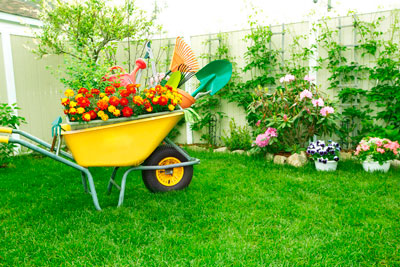The primary focus of a landscaping business is to decorate and mow lawns. You may also need to plant a variety of plants, trees, shrubs, and grasses, or replace lawns when necessary. Some of the larger landscaping companies even use organic herbicides and pesticides.
For these reasons, seasoned landscapers understand the science as well as the art of planting trees, flowers, and shrubs at appropriate times as well as the artistic placement of items such as brick, edging, rock, and other pleasing items on commercial or residential grounds.
How to start a landscaping business
As a landscaper, at least part of your day is spent keeping up with the essentials of running the business. This is the time to pay all bills, return or make phone calls. In addition, some time must be spent handling paperwork, scheduling, managing customer and employee relationships, and necessary marketing tasks.
Requirements to undertake as a landscaper:
- Create estimates
- Schedule jobs based on travel time and types of work involved
- Drive the necessary machinery
- Maneuvering a trailer pulled behind a truck
- Experience in the repair of small engines, it is not essential.
- A background in forestry or botany is a plus.
- Understanding of fertilizer for the growth of various species.
- Understanding chemicals to prevent pests.
- Understanding of the proper amounts of water needed for different plants and types of lawns.
- List of common business skills
Consideration of work during the initial phase:
- Lawn Care Professional
- Landscape professionals
- A crew member must have a good job, manage time effectively, and be responsible. A crew member must navigate to jobs, do manual work, keep time records, and be reliable to take on any tasks delegated by the supervisor.
- Common Staff Positions Needed to Run Some Businesses
 Approximate daily hours required:
Approximate daily hours required:
General hours of operation: Typical hours are generally around 6:00 am to 4:00 pm, depending on the amount of daylight. Expect to spend additional time if there is a change in weather.
Hours needed to prepare: Give yourself an hour to load equipment onto a truck and an hour or two to unload grass clippings, etc., and store, clean, and maintain equipment and supplies at the end of the workday.
Necessary equipment, supplies and services:
- Hedge trimmer, rakes, shovels, brooms, shovel / paddles
- Stand-On Mowers
- Suspended mowers
- Professional walk-behind mower
- Dethatcher Lawn
- Cage Trailer
- Pick-up truck
- Wheelbarrow
- Brush cutter
- chain saw
- Clippers
- Landscaping software
- Heavy duty gloves
- Tractor with accessories
- Large shed or rented / leased space to house equipment, supplies, chemicals, etc.
- Gas equipment (blowers, trimmers, edgers, etc.)
- Cherry pickers or other types of extension ladders
- Small bulldozer or earth bulldozer
- Personal safety equipment
- First aid kits
- Essential office equipment
Monthly expenses and operating costs to consider:
- Telephones (cell) and / or remote delivery service
- Maintenance of equipment and gasoline
- Truck and equipment insurance and civil liability
- Fertilizers and chemicals
- Fuel
- Rental of space / warehouse for the storage of equipment and supplies
- List of common business skills
Landscaping licenses and permits
If you offer services that require the use of toxic chemicals, you may need to obtain a license to handle those substances. You may also be required to participate in a class on chemical handling, use, toxicity, and storage.
Check with the local authorities in your area to obtain any additional permits or licenses that are required to run a landscaping business in your state.
Additionally, many states require certification for landscaping contractors to use certain chemicals and pesticides. The course is relatively inexpensive and generally lasts 6 to 8 weeks at a local university.
May need heavy equipment license and certification
Approximate minimum start-up cost:
- Essential: Tools and equipment, along with a truck, will cost approximately $ 7,500 – $ 15,000 to start.
Advantages and disadvantages:
Advantage:
- A landscaping business is one of the easiest to start
- Be your own boss and work your own hours
- Exterior work
- There is usually a lot of work available
- Easily expandable business
Disadvantages:
- Work tends to slow down during the winter months
- Requires a large amount of lifting and heavy transport of all types of machinery
- It may be necessary to handle toxic substances
- Requires working with potentially dangerous machinery
Type of customers you need to attract:
New home owners who want to replace a temporary lawn with landscaping care are major customers in the landscaping industry.
Homes where both parties work may not have adequate time to maintain their lawn and require gardening services on a weekly basis. Older individuals with higher incomes generally need landscaping renovations to refresh and maintain a beautiful lawn.
An abundance of non-residential clients also require the services of a landscaping business, such as apartment buildings, restaurants, corporate buildings, etc.
Business Landscaping Statistics
You will find a wide assortment of statistics, but the most current and reliable statistics for landscaping can be found in Valuation Resources. You can also check with your state or local government agriculture and other agencies.
Income received by a landscaper in the USA
Landscapers make the most money for commercial properties: roughly $ 60,000 to $ 80,000 per year; while residential landscapers generally do about half of that.
See: How to prepare a price sheet for a gardening business

